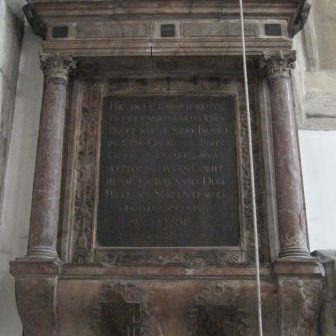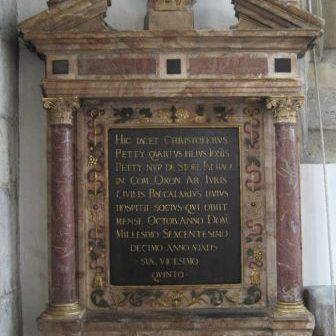Monument to Christopher Petty
A wall monument; 17th century; marble, alabaster, limestone, gilding & polychromy
The whole monument was heavily soiled with dust and dirt. It was also covered with a mixture of dirt, dust, tar and other airborne particles that had solidified into a stiff dark layer over the decades. This layer was firmly bound to the surface. Alabaster was heavily stained. Black 'marble' was bloomed. Most of the polychromy & gilding was missing. The remaining polychromy was heavily soiled and discoloured. Structurally, a proper left base the slope side of the broken pediment was on the verge of sliding down. Also, the coat of arms cartouche at the top was unstable and the whole alabaster piece was moving significantly when touched even slightly. Secondly, and more importantly, the iron rod/bracket was moving in and out of the wall. Regarding the rest of the monument, two out of five pateraes were missing. The shaft of the proper left column was deteriorating - the stone was delaminating and crumbling away. There were open gaps between some of the stone blocks and pointing was missing in several places. Old discoloured fills were present and small scratches and defects could be seen in several areas.
The surface cleaning was undertaken in several stages to ensure a gradual process. Different cleaning techniques were employed in accordance to the type of stone and its compatibility with it. Dry as well as wet cleaning techniques were used. The stubborn dark pollution layer was removed with a laser system. The original colour of the black 'marble' was achieved with a reviving solution. Areas of missing painting were in-painted (after analysing the original pigments) and areas of missing gilding were re-gilded. Newly gilded areas were de-stressed to make them blend in. Lettering was also re-gilded. Structurally, the cartouche and its metal rod were secured. The base on the pediment was fixed back into its place. Stainless steel rod was used for that as well. The crumbling stone was consolidated and the holes filled in. All new fills were in-painted to match the surrounding surface and old fills were improved. Areas of missing pointing were re-pointed. A protective layer of Renaissance wax was applied on the clean and dry stone surface. A great care was taken to achieve a homogenous appearance of the whole monument while staying true to the original colour scheme.
Client
All Souls College, Oxford


